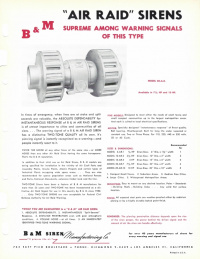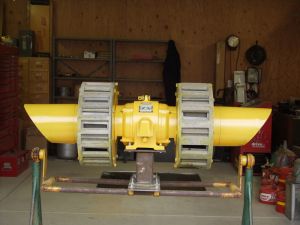B&M Air Raid Sirens
| B&M Air Raid Sirens | |

| |
| Company | B & M Siren Manufacturing Co. |
|---|---|
| Produced | 1930s(?) - 1960s(?) |
| Type | Electromechanical Omnidirectional |
B&M Siren Manufacturing Co, often shortened to B&M, is a manufacturer of vehicular and civil defense sirens, and is one of the oldest siren manufacturers, having been in business since 1913. While they currently only offer the Siro-Drift vehicular sirens, B&M used to produce large outdoor warning sirens during World War II and the Cold War. With other siren manufacturers having a much larger presence, B&M eventually discontinued their line of outdoor warning sirens due to declining sales. They are still around today restoring and building vehicular sirens.
History
B&M began making outdoor warning sirens sometime during the 1920s, as stationary sirens were mentioned as early as 1927. As World War II raged on and the Cold War loomed over the horizon, the demand for dual tone civil defense sirens was rising, to distinguish them from single tone fire sirens. B&M entered the market with a multitude of single and dual toned sirens, ranging from small single rotor sirens meant for tiny communities to large dual rotor sirens meant for big cities. These sirens had extremely efficient rotor designs, combining that with screaming high tones made for painfully loud sirens that can be heard for miles.
B&M continued making these civil defense sirens up until somewhere in the 1970s. It's likely that they couldn't keep up with competition from other manufacturers such as Federal or A.C.A., as B&M had poor advertising and high prices for their sirens. B&M ultimately opted to switch back to purely making vehicular sirens, which they continue to do to this day, along with restoring any siren you present to them. Today, there are few B&M civil defense sirens left, as all but one have been taken out of service due to age, replacement, or towns simply no longer having a need for them. However, B&M's vehicular sirens can still be found in widespread use today.
Products
General Alarms
6GA
The 6GA is B&M's smallest electric siren, being only 1/2 horsepower with a 6 inch, 6 port rotor, shared with the 6FA friction siren. Despite being so tiny and only running on 120V, the 6GA has proven to be extremely loud for its size, with a privately owned unit reaching 130 dBA from up close. The 6GA was also referred to as the 6-AR-1, as it was also sold under the air raid siren lineup as a siren for compact suburban areas. 6GAs were sold with bell shaped shrouds to cover the siren.
8GA
The 8GA is B&M's mid-size general alarm, equipped with an 8 inch, 8 port stator shared with B&M's vehicular sirens. The rotor is slightly different, having no need for the large clutch hub. They were sold with bell shaped shrouds to cover the siren. Few are known to exist in the wild, as the larger 10GA was a more popular choice.
10GA
The 10GA is B&M's largest general alarm siren, utilizing a 2.5 horsepower motor to turn a 10 inch, 8 port rotor. Especially popular in Texas and surrounding states, the 10GA is one of B&M's more common outdoor sirens. It was also referred to as the Model 10 and the Model 10-AR-2 under B&M's air raid siren lineup, being the second smallest siren of the pack. They were sold with bell shaped shrouds, or with fully enclosed shrouds as the Model 10.
Air Raid Sirens
20-AR-7

The 20-AR-7 is the mid-size dual end AR series siren, with two 20 inch stators and 18 1/8 rotors powered by a 7.5 horsepower motor. A good few units still remain today, albeit inactive or under private ownership. They came in 16/20 port standard, and no remaining examples have a different port ratio. The 16/20 port units are unique by using 8/10 port rotors inside of 16/20 port stators, with the rotor ports the same size as the stator ports. It is believed B&M did this to get more equal sound distribution out of the intakes and ports, leading to more uniform coverage. This would create two octave tones, making for a very odd sounding siren. The 20-AR-7 was best suited for large cities, according to B&M. B&M also offered a single rotor version of this siren, called the 20-AR. Four have been documented, and at least three exist today.
20-AR-10(•2T)
The 20-AR-10, or 20AR10•2T, is B&M's largest AR series siren, with two 20 inch stators and 18 1/8 rotors, longer than the rotors on a 20-AR-7 with the same diameter. The 20-AR-10 is driven by a dual sided 10HP AC motor. It was sold in 12/16 port with 6/8 port rotors, full 14/16 port, and possibly more that may currently be unknown. 6 examples are known to remain today, one being incomplete with only one 14 port rotor and the motor at B&M's facility, a display unit at an Orange County, CA fire station, Sierra Madre, CA's siren, Carlisle, PA's siren, Perris, CA's siren and a display unit at the Mojave Desert Historical & Cultural Association (MDHCA.org) in Goffs, CA. The 20-AR-10 was best suited for widespread metropolitan areas, according to B&M.
H Series
15-H-2
The 15-H-2 is the smallest siren in the H Series lineup, being just 3 horsepower with two 15 inch rotors. The rotors are 6 port, and the stators are 12 port, making for a heavier undertone. Most likely because of it's price, the 15-H-2 was not a popular choice, being only $50 less than the 15-H-4 at the time. None are known to exist.
15-H-4
The 15-H-4 is the second siren in the H Series lineup, it has two 15 inch rotors driven by a 5 horsepower motor. The 15-H-4 is similar to the 15-H-2, just having longer rotors and a larger motor. Like the 15-H-2, the 15-H-4 is a 6/6 port siren with 12 port stators. All 15-H-4s known to exist have stator flanges for stator shrouds to be mounted, and one 15-H-4 in Kingman, AZ has the stator shrouds and horn extensions on the intakes. The 15-H-4 is the most common siren of the H Series, as it was much cheaper than the largest H Series siren, but only slightly more than the 15-H-2. It is also believed that the 15-H-4 was sold later on as the 15-AR-5, with little to no changes.
18-H-7
The 18-H-7 was the largest siren in the H series lineup, presumably with two 18 inch rotors and a 10 horsepower motor. Not much is known about the 18-H-7, as it likely never sold well due to being double the price of a 15-H-4. None have ever been documented, and none are known to exist today.
Steam Driven Siren
B&M produced at least one steam powered siren for the Atchison, Topeka & Santa Fe (ATSF) Railway in San Bernardino, California for use at their freight railyards. The 7 port siren has a turbine in the rear which drives the rotor to roughly 4,500 RPM when supplied with steam from the railroad shop it was mounted on. It was expected to be audible as far as 6 miles away in Highland, CA, but whether or not that was met is unknown. One of these sirens was once located on top of a building in the railroad's San Bernardino yard and was used for air raid and general alarms, before being taken out of service and donated to a museum.